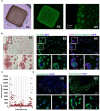3D bioprinted CRC model brings to light the replication necessity of an oncolytic vaccinia virus encoding FCU1 gene to exert an efficient anti-tumoral activity
- PMID: 39091906
- PMCID: PMC11292208
- DOI: 10.3389/fonc.2024.1384499
3D bioprinted CRC model brings to light the replication necessity of an oncolytic vaccinia virus encoding FCU1 gene to exert an efficient anti-tumoral activity
Abstract
The oncolytic virus represents a promising therapeutic strategy involving the targeted replication of viruses to eliminate cancer cells, while preserving healthy ones. Despite ongoing clinical trials, this approach encounters significant challenges. This study delves into the interaction between an oncolytic virus and extracellular matrix mimics (ECM mimics). A three-dimensional colorectal cancer model, enriched with ECM mimics through bioprinting, was subjected to infection by an oncolytic virus derived from the vaccinia virus (oVV). The investigation revealed prolonged expression and sustained oVV production. However, the absence of a significant antitumor effect suggested that the virus's progression toward non-infected tumoral clusters was hindered by the ECM mimics. Effective elimination of tumoral cells was achieved by introducing an oVV expressing FCU1 (an enzyme converting the prodrug 5-FC into the chemotherapeutic compound 5-FU) alongside 5-FC. Notably, this efficacy was absent when using a non-replicative vaccinia virus expressing FCU1. Our findings underscore then the crucial role of oVV proliferation in a complex ECM mimics. Its proliferation facilitates payload expression and generates a bystander effect to eradicate tumors. Additionally, this study emphasizes the utility of 3D bioprinting for assessing ECM mimics impact on oVV and demonstrates how enhancing oVV capabilities allows overcoming these barriers. This showcases the potential of 3D bioprinting technology in designing purpose-fit models for such investigations.
Keywords: bioprinting; colorectal (colon) cancer; hydrogel; oncovirus; tumor.
Copyright © 2024 Marquette, Petiot, Spindler, Ebel, Nzepa, Moreau, Erbs, Balloul, Quemeneur and Zaupa.
Conflict of interest statement
Author AS, CE, MN, BM, PE, J-MB, EQ and CZ were employed by company Transgene SA. The remaining authors declare that the research was conducted in the absence of any commercial or financial relationships that could be construed as a potential conflict of interest.
Figures




Similar articles
-
Enhancing therapeutic efficacy of oncolytic vaccinia virus armed with Beclin-1, an autophagic Gene in leukemia and myeloma.Biomed Pharmacother. 2020 May;125:110030. doi: 10.1016/j.biopha.2020.110030. Epub 2020 Feb 27. Biomed Pharmacother. 2020. PMID: 32187960
-
An oncolytic vaccinia virus expressing anti-CD47 nanobody exerts enhanced antitumor activity by mediating innate and adaptive immune cell infiltration and activation in the lymphoma tumor microenvironment.Haematologica. 2025 Apr 10. doi: 10.3324/haematol.2024.286923. Online ahead of print. Haematologica. 2025. PMID: 40207734
-
CD19-targeted BiTE expression by an oncolytic vaccinia virus significantly augments therapeutic efficacy against B-cell lymphoma.Blood Cancer J. 2022 Feb 28;12(2):35. doi: 10.1038/s41408-022-00634-4. Blood Cancer J. 2022. PMID: 35228544 Free PMC article.
-
Preclinical and clinical trials of oncolytic vaccinia virus in cancer immunotherapy: a comprehensive review.Cancer Biol Med. 2023 Aug 23;20(9):646-61. doi: 10.20892/j.issn.2095-3941.2023.0202. Cancer Biol Med. 2023. PMID: 37615308 Free PMC article. Review.
-
Recent progress in combination therapy of oncolytic vaccinia virus.Front Immunol. 2024 Mar 13;15:1272351. doi: 10.3389/fimmu.2024.1272351. eCollection 2024. Front Immunol. 2024. PMID: 38558795 Free PMC article. Review.
References
LinkOut - more resources
Full Text Sources

